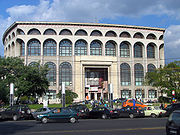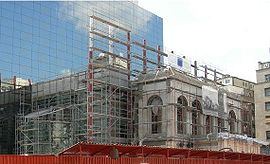
National Theatre Bucharest
Encyclopedia

Romania
Romania is a country located at the crossroads of Central and Southeastern Europe, on the Lower Danube, within and outside the Carpathian arch, bordering on the Black Sea...
, located in the capital city of Bucharest
Bucharest
Bucharest is the capital municipality, cultural, industrial, and financial centre of Romania. It is the largest city in Romania, located in the southeast of the country, at , and lies on the banks of the Dâmbovița River....
.
Founding
It was founded as the Teatrul cel Mare din Bucureşti ("Grand Theatre of Bucharest") in 1852, its first director being Costache CaragialeCostache Caragiale
Costache Caragiale was a Romanian actor and theatre manager who had an important role in the development of the Romanian theatre....
. It became a national institution in 1864 by a decree of Prime Minister Mihail Kogălniceanu
Mihail Kogalniceanu
Mihail Kogălniceanu was a Moldavian-born Romanian liberal statesman, lawyer, historian and publicist; he became Prime Minister of Romania October 11, 1863, after the 1859 union of the Danubian Principalities under Domnitor Alexander John Cuza, and later served as Foreign Minister under Carol I. He...
, and was officially named as the National Theatre in 1875; it is now administered by the Romanian Ministry of Culture
Ministry of Culture and Religious Affairs of Romania
The Ministry of Culture and National Patrimony of Romania is one of the fifteen ministries of the Government of Romania.The current Minister is Hunor Kelemen, member of the Democratic Union of Hungarians in Romania....
.
In April 1836, the Societatea Filarmonica — a cultural society founded by Ion Heliade Rădulescu
Ion Heliade Radulescu
Ion Heliade Rădulescu or Ion Heliade was a Wallachian-born Romanian academic, Romantic and Classicist poet, essayist, memoirist, short story writer, newspaper editor and politician...
and Ion Câmpineanu — bought the Câmpinencii Inn to build a National Theatre on the site, and began to collect money and materials for this purpose. In 1840, Obşteasca Adunare (the legislative branch established under the terms of the Imperial Russian-approved Organic Statute
Regulamentul Organic
Regulamentul Organic was a quasi-constitutional organic law enforced in 1834–1835 by the Imperial Russian authorities in Moldavia and Wallachia...
) proposed to Alexandru II Ghica
Alexandru II Ghica
Alexandru II or Alexandru D. Ghica , a member of the Ghica family, was Prince of Wallachia from April 1834 to 7 October 1842 and later caimacam from July 1856 to October 1858....
, the Prince of Wallachia
Wallachia
Wallachia or Walachia is a historical and geographical region of Romania. It is situated north of the Danube and south of the Southern Carpathians...
, a project to build a National Theatre with state support. The request was approved on June 4, 1840. Prince Gheorghe Bibescu
Gheorghe Bibescu
Gheorghe Bibescu was a hospodar of Wallachia between 1843 and 1848. His rule coincided with the revolutionary tide that culminated in the 1848 Wallachian revolution.-Early political career:...
adopted the idea of founding the theatre and chose a new location, on the spot of the former Filaret Inn. There were several reasons to favor this locations: it was centrally located, right in the middle of Podul Mogoşoaiei (today's Calea Victoriei
Calea Victoriei
Calea Victoriei is a major avenue in central Bucharest. It leads from Splaiul Independenţei to the north and then northwest up to Piaţa Victoriei, where Şoseaua Kiseleff continues north....
); the earthquake of 1838 had damaged the inn beyond repair, and it needed to be torn down.
Old building
The August 13, 1843, report of the commission charged with building the theatre determined that construction would cost 20,300 Austrian guilderAustro-Hungarian gulden
The Gulden or forint was the currency of the Austrian Empire and later the Austro-Hungarian Empire between 1754 and 1892 when it was replaced by the Krone/korona as part of the introduction of the gold standard. In Austria, the Gulden was initially divided into 60 Kreuzer, and in Hungary, the...
(standard gold coin
Gold coin
A gold coin is a coin made mostly or entirely of gold. Gold has been used for coins practically since the invention of coinage, originally because of gold's intrinsic value...
s, a sum worth about US$45,000 at the time), of which only 13,000 gold coins were available. In 1846, a new commission engaged the Vienese
Vienna
Vienna is the capital and largest city of the Republic of Austria and one of the nine states of Austria. Vienna is Austria's primary city, with a population of about 1.723 million , and is by far the largest city in Austria, as well as its cultural, economic, and political centre...
architect A. Hefft, who came up with an acceptable plan.
Construction got under way in 1848, only to be interrupted in June by the Wallachian revolution. In August 1849, after Prince Barbu Dimitrie Ştirbei
Barbu Dimitrie Stirbei
Barbu Dimitrie Ştirbei , a member of the Bibescu boyar family, was a Prince of Wallachia on two occasions, in 1848–1853 and in 1854–1856.-Early life:...
took power, he ordered that construction be completed.

Vaudeville
Vaudeville was a theatrical genre of variety entertainment in the United States and Canada from the early 1880s until the early 1930s. Each performance was made up of a series of separate, unrelated acts grouped together on a common bill...
with songs". The building was built in the baroque
Baroque
The Baroque is a period and the style that used exaggerated motion and clear, easily interpreted detail to produce drama, tension, exuberance, and grandeur in sculpture, painting, literature, dance, and music...
style, with 338 stalls on the main floor, three levels of loges, a luxurious foyer with staircases of Carrara
Carrara
Carrara is a city and comune in the province of Massa-Carrara , notable for the white or blue-grey marble quarried there. It is on the Carrione River, some west-northwest of Florence....
marble and a large gallery in which students could attend free of charge. For its first two years, the theatre was lit with tallow
Tallow
Tallow is a rendered form of beef or mutton fat, processed from suet. It is solid at room temperature. Unlike suet, tallow can be stored for extended periods without the need for refrigeration to prevent decomposition, provided it is kept in an airtight container to prevent oxidation.In industry,...
lamps, but from 1854 it used rape oil lamps; still later this was replaced by gaslight
Gas lighting
Gas lighting is production of artificial light from combustion of a gaseous fuel, including hydrogen, methane, carbon monoxide, propane, butane, acetylene, ethylene, or natural gas. Before electricity became sufficiently widespread and economical to allow for general public use, gas was the most...
s and eventually electric lights. In 1875, at the time its name was changed to Teatrul Naţional, its director was the writer Alexandru Odobescu
Alexandru Odobescu
Alexandru Ioan Odobescu was a Romanian author, archaeologist and politician.-Biography:He was born in Bucharest, the second child of General Ioan Odobescu and his wife Ecaterina. After attending Saint Sava College and, from 1850, a Paris lycée, he took the baccalauréat in 1853 and studied...
.
The historic theatre building on Calea Victoriei
Calea Victoriei
Calea Victoriei is a major avenue in central Bucharest. It leads from Splaiul Independenţei to the north and then northwest up to Piaţa Victoriei, where Şoseaua Kiseleff continues north....
— now featured on the 100-leu banknote — was destroyed during the Luftwaffe
Luftwaffe
Luftwaffe is a generic German term for an air force. It is also the official name for two of the four historic German air forces, the Wehrmacht air arm founded in 1935 and disbanded in 1946; and the current Bundeswehr air arm founded in 1956....
bombardment of Bucharest on August 24, 1944 (see Bombing of Bucharest in World War II
Bombing of Bucharest in World War II
The Bucharest World War II bombings were primarily Allied bombings of railroad targets and those of the Oil Campaign of World War II, but included a bombing by Nazi Germany after the royal coup. Bucharest stored and distributed much of Ploiești's refined oil products....
).
The modern theatre
The current National Theatre is located about half a kilometre away from the old site, just south of the Hotel Intercontinental at Piaţa Universităţii (University Square), and has been in use since 1973.It forms part of a complex that also includes the Romanian National Operetta, an art gallery and exhibition space, and several of the city's most prominent bars, including the massive rooftop terrace La Motoare. The present facility includes:
- Sala Mare ("the Large Hall"), with 1,155 seats;
- Sala Amfiteatru ("the Amphitheatre Hall"), with 353 seats;
- Sala Atelier ("the Studio Theatre") with no fixed stage, with 94-219 seats depending on how it is configured;
- Sala Studio 99, also without a fixed stage, seating 75-99 people.

